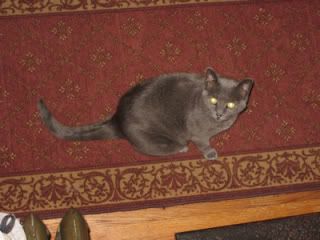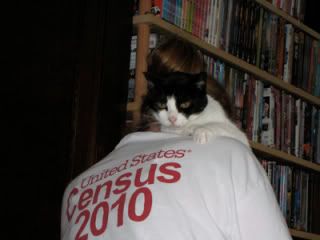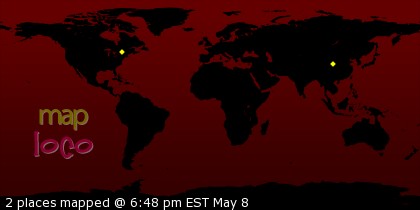Lou Anders (Editorial Director of Pyr Books), Ginjer Buchanan (Editor-in-Chief of Ace/Roc Books) and Jeremy Lassen (Editor-in-Chief of Nightshade Books) are having a discussion this week over on Border's SciFi blog BabelClash about publishing, the role of the editor, and the like. Especially interesting so far (IMO) were Lou and Ginjer's posts on what they do (and don't do) as editors, as well as Jeremy's take on the relationship among editors when it comes to acquisitions and the like.
In other related news (via Jim Hines), SFWAs Writer Beware Blog has an excellent post by Victoria Strauss about why Getting Published in Not a Crap Shoot. I also recommend Jim's archived post on SFNovelists about talent vs. skill in regards to getting published (as well as his great rant against the myth that publishers and agents are trying to lock new writers out.)
There, now it almost feels like I generated content. Happy reading (and writing, of course).
ETA: Most may already know this, but it bears repeating: astronomers have discovered an earth-like planet inhabiting the "Goldilocks Zone" around the star Gliese 581. This is the best candidate we have yet for finding another planet that could harbor life--and it's right next door (well, in galactic terms; for you and me, 120 trillion miles is still a hell of a commute). How awesomely SciFi is that?
Thursday, September 30, 2010
Wednesday, September 29, 2010
Howling Haikus
Okay, this is just too fun not to pass on... over at The Bite Club blog, they're holding a contest for werewolf haikus.
Tuesday, September 28, 2010
The Perils of a Double-Life
Do you ever wonder if Bruce Wayne is jealous of Batman? Or visa versa?
I'm jealous of my pseudonym today. Over the weekend I discovered that the Japanese publication of Archangel Protocol is also out of print.

This means that as Lyda Morehouse, I have failed to stay in print anywhere in the world. Of course, I can't exactly cry since I'll have a new book in the AngeLINK universe coming out in March of next year. However, Tate Hallaway has yet to be remaindered. All of her works are still in print (her first book is in its sixth printing, no less), and, thanks to being included in an anthology with much bigger names, she's been translated into English (British), German, Polish, and, I just found out yesterday, soon to be into Russian.
Man, I hate that girl.
I'm jealous of my pseudonym today. Over the weekend I discovered that the Japanese publication of Archangel Protocol is also out of print.

This means that as Lyda Morehouse, I have failed to stay in print anywhere in the world. Of course, I can't exactly cry since I'll have a new book in the AngeLINK universe coming out in March of next year. However, Tate Hallaway has yet to be remaindered. All of her works are still in print (her first book is in its sixth printing, no less), and, thanks to being included in an anthology with much bigger names, she's been translated into English (British), German, Polish, and, I just found out yesterday, soon to be into Russian.
Man, I hate that girl.
Monday, September 27, 2010
Astronomy Photo of the Day from NASA

What drives auroras on Saturn? To help find out, scientists have sorted through hundreds of infrared images of Saturn taken by the Cassini spacecraft for other purposes, trying to find enough aurora images to correlate changes and make movies. Once made, some movies clearly show that Saturnian auroras can change not only with the angle of the Sun, but also as the planet rotates. Furthermore, some auroral changes appear related to waves in Saturn's magnetosphere likely caused by Saturn's moons. Pictured above, a false-colored image taken in 2007 shows Saturn in three bands of infrared light. The rings reflect relatively blue sunlight, while the planet itself glows in comparatively low energy red. A band of southern aurora in visible in green. Inspection of many more Saturnian images may well lead to an even better understanding of both Saturn's and Earth's auroras.
Sunday, September 26, 2010
Astronomy Photo of the Day from NASA

Why does this galaxy have such a long tail? In this stunning vista recorded with the Hubble Space Telescope's Advanced Camera for Surveys, distant galaxies form a dramatic backdrop for disrupted spiral galaxy Arp 188, the Tadpole Galaxy. The cosmic tadpole is a mere 420 million light-years distant toward the northern constellation Draco. Its eye-catching tail is about 280 thousand light-years long and features massive, bright blue star clusters. One story goes that a more compact intruder galaxy crossed in front of Arp 188 - from left to right in this view - and was slung around behind the Tadpole by their gravitational attraction. During the close encounter, tidal forces drew out the spiral galaxy's stars, gas, and dust forming the spectacular tail. The intruder galaxy itself, estimated to lie about 300 thousand light-years behind the Tadpole, can be seen through foreground spiral arms at the lower left. Following its terrestrial namesake, the Tadpole Galaxy will likely lose its tail as it grows older, the tail's star clusters forming smaller satellites of the large spiral galaxy.
Saturday, September 25, 2010
Something Really Cool
What I love about the SF/F community is that even when things like "Race: Fail" and "the Moon situation" happen, someone does something really cool.
Apex is having an all Muslim/Arab issue in November.
Since I'm not qualified to contribute, I did the next best thing, I subscribed.
Apex is having an all Muslim/Arab issue in November.
Since I'm not qualified to contribute, I did the next best thing, I subscribed.
Friday, September 24, 2010
Friday Cat Blogging
Thursday, September 23, 2010
Astronomy Photo of the Day

Today, the Sun crosses the celestial equator heading south at 03:09 Universal Time. Known as an equinox, this astronomical event marks the first day of autumn in the northern hemisphere and spring in the south. Equinox means equal night. With the Sun on the celestial equator, Earth dwellers will experience nearly 12 hours of daylight and 12 hours of darkness. Of course, in the north the days continue to grow shorter, the Sun marching lower in the sky as winter approaches. To celebrate the equinox, consider this view of the Sun in extreme ultraviolet light from the Sun staring Solar Dynamics Observatory. Recorded yesterday, the false-color image shows emission from highly ionized iron atoms. Loops and arcs trace the glowing plasma suspended in magnetic fields above solar active regions.
Wednesday, September 22, 2010
Your Dream Job?
Wizards of the Coast is looking for a books editor (D&D):
Your dream job?
I would apply, myself, but you have to have good proofreading skills.
Your dream job?
I would apply, myself, but you have to have good proofreading skills.
Tuesday, September 21, 2010
More
Jon made a comment on my last post that suggests I have not been clear.
I was trying to make three arguments:
1) Obligations of day to day life can interfere with productivity.
2) Some writers are more prolific than others, for whatever reason.
3) For many writers, writing is not easy.
I was also trying to distinguish between the mind set of a practical writer and the mind set a 'fine art' writer. It would be nice if some of the other Wyrdsmiths would jump into this discussion, since we probably have some differences of opinion about this.
I was trying to make three arguments:
1) Obligations of day to day life can interfere with productivity.
2) Some writers are more prolific than others, for whatever reason.
3) For many writers, writing is not easy.
I was also trying to distinguish between the mind set of a practical writer and the mind set a 'fine art' writer. It would be nice if some of the other Wyrdsmiths would jump into this discussion, since we probably have some differences of opinion about this.
Writing
As Kelly has mentioned, John Scalzi has a long post on writing on his blog. Here is part of it.
I mentioned this to my friend Ruth Berman, and she said, "This isn't true. There are times when I am simply not able to write."
Ruth is a fine poet, prolific compared to me, and also a fine writer of short fiction, though she has written more poetry than fiction in recent years. She mostly publishes in literary magazines, though she has also published poetry and fiction in Asimov's, among other SF places.
I would call Scalzi a production writer, producing novels the way a production weaver produces scarves and a production potter produces pots and mugs. Like such artists, he has a workmanlike and practical attitude toward what he does.
I would say that Ruth and Scalzi are two different kinds of writers, and that what's true for one may not be true for the other.
I am on the Ruth end of the writing spectrum. Scalzi is able to make a living from writing. I cannot, and I have always been the main support of my own personal household. I think there's no question that working a day job has cut into my writing time and energy. Often, I have been able to write in spite of the day job. But as I aged and as my jobs became more interesting and demanding, I wrote less and less. Now that I am unemployed or retired, take your pick, I am writing more.
Like Ruth, I have often had the experience of not being able to write. Wherever the writing comes from is empty. I have to wait till it refills. Could I force the writing to come? I'm not sure. I know there are times when the words come with difficulty, and they are dead on the page.
Over the past 40 years, I have averaged something like 28,000 words a year. This is one novella or several short stories a year. After three or four years of work, I have a novel. My longest novel, A Woman of the Iron People, took 13 years instead of 7, because I took a long break in the middle and wrote another novel. I did this because I simply did not know where Woman was going.
Could I have written more if I'd been more disciplined? Maybe, and maybe I would have produced pages full of dead words, and stories that were not -- ultimately -- about anything.
What I'm trying to do when I write is create a work of art that is distinctive and personal, that says something I've never said before, that pulls as deeply as possible from whoever I am. I want the words to be alive. I want the story to have ideas that are seriously considered. I want it to be my best effort at describing what it's like to be human and live in this universe. Yes, I want my writing to be entertaining. But I also want it to be serious art that tries to meet the standards of the very best art.
When I write something that doesn't feel alive, that doesn't feel like my best effort, I trash it or put it away till I feel I can finish it.
Am I saying Scalzi doesn't do this? I have no idea, since I have read very little of his work.
I think he's wrong when he says writing isn't hard. I've done it a long time, and I find it quite difficult.
If you want to be a writer, than be a writer, for god’s sake. It’s not that hard, and it doesn’t require that much effort on a day to day basis. Find the time or make the time. Sit down, shut up and put your words together. Work at it and keep working at it. And if you need inspiration, think of yourself on your deathbed saying “well, at least I watched a lot of TV.” If saying such a thing as your life ebbs away fills you with existential horror, well, then. I think you know what to do.
I mentioned this to my friend Ruth Berman, and she said, "This isn't true. There are times when I am simply not able to write."
Ruth is a fine poet, prolific compared to me, and also a fine writer of short fiction, though she has written more poetry than fiction in recent years. She mostly publishes in literary magazines, though she has also published poetry and fiction in Asimov's, among other SF places.
I would call Scalzi a production writer, producing novels the way a production weaver produces scarves and a production potter produces pots and mugs. Like such artists, he has a workmanlike and practical attitude toward what he does.
I would say that Ruth and Scalzi are two different kinds of writers, and that what's true for one may not be true for the other.
I am on the Ruth end of the writing spectrum. Scalzi is able to make a living from writing. I cannot, and I have always been the main support of my own personal household. I think there's no question that working a day job has cut into my writing time and energy. Often, I have been able to write in spite of the day job. But as I aged and as my jobs became more interesting and demanding, I wrote less and less. Now that I am unemployed or retired, take your pick, I am writing more.
Like Ruth, I have often had the experience of not being able to write. Wherever the writing comes from is empty. I have to wait till it refills. Could I force the writing to come? I'm not sure. I know there are times when the words come with difficulty, and they are dead on the page.
Over the past 40 years, I have averaged something like 28,000 words a year. This is one novella or several short stories a year. After three or four years of work, I have a novel. My longest novel, A Woman of the Iron People, took 13 years instead of 7, because I took a long break in the middle and wrote another novel. I did this because I simply did not know where Woman was going.
Could I have written more if I'd been more disciplined? Maybe, and maybe I would have produced pages full of dead words, and stories that were not -- ultimately -- about anything.
What I'm trying to do when I write is create a work of art that is distinctive and personal, that says something I've never said before, that pulls as deeply as possible from whoever I am. I want the words to be alive. I want the story to have ideas that are seriously considered. I want it to be my best effort at describing what it's like to be human and live in this universe. Yes, I want my writing to be entertaining. But I also want it to be serious art that tries to meet the standards of the very best art.
When I write something that doesn't feel alive, that doesn't feel like my best effort, I trash it or put it away till I feel I can finish it.
Am I saying Scalzi doesn't do this? I have no idea, since I have read very little of his work.
I think he's wrong when he says writing isn't hard. I've done it a long time, and I find it quite difficult.
Monday, September 20, 2010
So your man can smell like the sea...in a bad way
In the tradition of paying occasional homage to the Old Ones on this blog, I am insanely horrified to present....
Sunday, September 19, 2010
A couple quick Smart Things
A quick appetizer of Smart Things for Sunday night/Monday morning:
Brent Weeks and Brandon Sanderson had a wide-ranging discussion about epic fantasy over on BabelClash this week. Topics ranged from pacing, to foreshadowing, to chapter lengths and cliff-hangers, and so on (the discussion starts at the bottom and scrolls up, 'natch). I'm not sure I agree with them 100% on chapter endings or purpose, but then again, I am writing on a different scope and scale, which can impact structure quite a bit.
For a prime example of what NOT to do when querying a publisher, and said publisher's reaction to it, hop on over to Atomic Fez for a good chuckle. (For a basic overview on how to structure a query letter, check out Lynn Flewlling's article "The Complete Nobody's Guide to Query Letters" over on the SFWA site.)
I'd hunt down and post more but, well, I really should be writing...
Brent Weeks and Brandon Sanderson had a wide-ranging discussion about epic fantasy over on BabelClash this week. Topics ranged from pacing, to foreshadowing, to chapter lengths and cliff-hangers, and so on (the discussion starts at the bottom and scrolls up, 'natch). I'm not sure I agree with them 100% on chapter endings or purpose, but then again, I am writing on a different scope and scale, which can impact structure quite a bit.
For a prime example of what NOT to do when querying a publisher, and said publisher's reaction to it, hop on over to Atomic Fez for a good chuckle. (For a basic overview on how to structure a query letter, check out Lynn Flewlling's article "The Complete Nobody's Guide to Query Letters" over on the SFWA site.)
I'd hunt down and post more but, well, I really should be writing...
Astronomy Photo of the Day

What dark forms lurk in the mists of the Carina Nebula? These ominous figures are actually molecular clouds, knots of molecular gas and dust so thick they have become opaque. In comparison, however, these clouds are typically much less dense than Earth's atmosphere. Pictured above is part of the most detailed image of the Carina Nebula ever taken, a part where dark molecular clouds are particularly prominent. The image has recently been retaken and then re-colored based on light emitted by oxygen. The entire Carina Nebula spans over 300 light years and lies about 7,500 light-years away in the constellation of Carina. NGC 3372, known as the Great Nebula in Carina, is home to massive stars and changing nebula. Eta Carinae, the most energetic star in the nebula, was one of the brightest stars in the sky in the 1830s, but then faded dramatically. Wide-field annotated and zoomable versions of the larger image composite are also available.
Friday, September 17, 2010
Friday Cat Blogging
Smart Things
In no particular order.
John Scalzi on either writing matters enough to you that you find the time to write. Or you don't. Harsh but true.
Douglas Martini on dating writers. Both funny and a fair amount of truth to be found here.
Cat Valente on what a con takes out of you if you're doing it as a pro and part of your job.
On a related note, Lilith Saintcrow on the costs of writing. It isn't easy and it isn't effort free.
Kristin Nelson on the incredible power of story. This one makes me quite snuffly.
Kristin Nelson on interesting developments in the ebook market, and why royalties are almost certainly going to go up if publishers want to keep writers in the fold.
John Scalzi on either writing matters enough to you that you find the time to write. Or you don't. Harsh but true.
Douglas Martini on dating writers. Both funny and a fair amount of truth to be found here.
Cat Valente on what a con takes out of you if you're doing it as a pro and part of your job.
On a related note, Lilith Saintcrow on the costs of writing. It isn't easy and it isn't effort free.
Kristin Nelson on the incredible power of story. This one makes me quite snuffly.
Kristin Nelson on interesting developments in the ebook market, and why royalties are almost certainly going to go up if publishers want to keep writers in the fold.
Thursday, September 16, 2010
Listen to Me!

MANY BLOODY RETURNS is now available as an audio book from Audiobook Stand.com. My short story "Fire and Ice and Linguine for Two" is collected therein. The theme of the anthology is vampires and birthdays, so my story involves Garnet and Sebastian's wacky attempt to celebrate his birthday one Christmas. For those of you who have read HONEYMOON OF THE DEAD, this story is actually the first appearace of Fonn, the Frost Giant.
I've pointed you to the .mp3 version, but it's also available as a CD. I might have to order both, since the CD will fit nicely on my bookshelf of achievements, and I can actually listen to the .mp3.
I'm psyched about this because I've NEVER had anything of mine appear in audio format before. It's going to be weird/cool to hear someone ELSE read my words.
Wednesday, September 15, 2010
Fighting Oil with Ink

I donated a short story reprint to the anthology, BREAKING WAVES: AN ANTHOLOGY OF GULF COAST RELIEF. This is an e-book available in a number of formats from Book View Cafe. 100% of the proceeds go to the Gulf Coast Relief Fund. Contributors include Ursula K. LeGuin, Vonda McIntyre, David D. Levine, Sarah Monette, David B. Coe, Kristine Kathryn Rusch and many more.
The theme is ecological disasters with hopeful endings (preferably involving the ocean.) Mine is "Indigo Bunting," which is a strange coming of age story in a recovering post-nuclear winter Yellowstone National Park.
Tuesday, September 14, 2010
Astronomy Photo of the Day (Courtesy of NASA)

What created the strange spiral structure on the left? No one is sure, although it is likely related to a star in a binary star system entering the planetary nebula phase, when its outer atmosphere is ejected. The huge spiral spans about a third of a light year across and, winding four or five complete turns, has a regularity that is without precedent. Given the expansion rate of the spiral gas, a new layer must appear about every 800 years, a close match to the time it takes for the two stars to orbit each other. The star system that created it is most commonly known as LL Pegasi, but also AFGL 3068. The unusual structure itself has been cataloged as IRAS 23166+1655. The above image was taken in near- infrared light by the Hubble Space Telescope. Why the spiral glows is itself a mystery, with a leading hypothesis being illumination by light reflected from nearby stars.
Click to enlarge and see more clearly. Pretty cool.
Monday, September 13, 2010
Techno Diva
A lot of people have been writing me to ask when the next book in the vampire princess of St. Paul series will be coming out. Answer: I still don't know exactly. It's on my contract somewhere, but I have no idea where my contract is right now other than "in the house." (My filing system leaves a lot to be desired.)
But I do know that the second book is coming along. On Friday, I got what used to be the "editorial letter." Now, it's an email that has a couple of macro comments as well as the manuscript marked up (line-by-line) by my editor.
Way back in the early 90s when I started my life as a professional writer, I used to get an email with notes like "pg. 145, second paragraph, which begins 'Once upon a time...' change to be less cliche?" Having the actual manuscript with the comments function turned on makes the process more convenient and, strangely, a heckuva lot more work.
I'm sure it wouldn't seem like more work to a writer who has never experienced any other method. I mean, can you even imagine hunting through a manuscript that way any more? But, I find that while I can easily see exactly where my editor wants work thanks to the comments, I tend to feel compelled to respond. I don't just respond, either. Because it's a simple click and type, suddenly, I find myself writing a mini-thesis on my word choice decisions, characterization, etc. In short, I'm a much bigger diva thanks to the convenience of technology.
It the early days, I would grumble quietly to myself and either make (or not) the changes while going over the entire novel.
Now, I find I flit right to the next comment and not re-read the whole thing. (I tend to skim the bits that aren't marked-up.) That targeted revision is the quicker, more convenient part, at least. But, as you can tell, I worry that I'm not nearly as thorough as I used to be.
Technology is a weird thing. It's such a lie that it makes our lives easier. Busier, yes, but easier? I'm not convinced. Plus, when I don't want to be revising, the Internets are right there to distract me.
Oh, shiny!
But I do know that the second book is coming along. On Friday, I got what used to be the "editorial letter." Now, it's an email that has a couple of macro comments as well as the manuscript marked up (line-by-line) by my editor.
Way back in the early 90s when I started my life as a professional writer, I used to get an email with notes like "pg. 145, second paragraph, which begins 'Once upon a time...' change to be less cliche?" Having the actual manuscript with the comments function turned on makes the process more convenient and, strangely, a heckuva lot more work.
I'm sure it wouldn't seem like more work to a writer who has never experienced any other method. I mean, can you even imagine hunting through a manuscript that way any more? But, I find that while I can easily see exactly where my editor wants work thanks to the comments, I tend to feel compelled to respond. I don't just respond, either. Because it's a simple click and type, suddenly, I find myself writing a mini-thesis on my word choice decisions, characterization, etc. In short, I'm a much bigger diva thanks to the convenience of technology.
It the early days, I would grumble quietly to myself and either make (or not) the changes while going over the entire novel.
Now, I find I flit right to the next comment and not re-read the whole thing. (I tend to skim the bits that aren't marked-up.) That targeted revision is the quicker, more convenient part, at least. But, as you can tell, I worry that I'm not nearly as thorough as I used to be.
Technology is a weird thing. It's such a lie that it makes our lives easier. Busier, yes, but easier? I'm not convinced. Plus, when I don't want to be revising, the Internets are right there to distract me.
Oh, shiny!
Friday, September 10, 2010
Wednesday, September 08, 2010
Shameless Self-Promotion

A short story of mine appears in Northern Lights: 20 MinnSpec Tales edited by Michael Mirriam which is now available for purchase through Genre Mall (Sam's Dot Publishing). My story, "Bright, Bright City Lights," has never before appeared in print, and was my attempt to deal with the death of Senator Paul Wellstone with... magic and the Irish Republican Army. Anyway, even if you find the conceit of my story to be a bit weird, surely you will find something to enjoy given the list of talented Minnesota writers involved in this anthology, which includes:
Jaye Lawrence, Catherine Lundoff, Haddayr Copley-Woods, Jason D. Wittman, David Steffen, Kelly Barnhill, Damian Sheridan, R. Scott McCoy, Terry Faust, Lyda Morehouse, Carrie Devall, Michael Merriam, Patrick Sullivan, Roy C. Booth, Britt Aamodt, Sharon Boerbon Hanson, Joel Arnold, Abra Staffin-Wiebe, Maggie Della Rocca and Hilary Moon Murphy.
Monday, September 06, 2010
Astronomy Photo of the Day
This amazing photo is credited to the European Southern Observatory. Click on it. It's even better when it's larger.


Why are these people shooting a powerful laser into the center of our Galaxy? Fortunately, this is not meant to be the first step in a Galactic war. Rather, astronomers at the Very Large Telescope (VLT) site in Chile are trying to measure the distortions of Earth's ever changing atmosphere. Constant imaging of high-altitude atoms excited by the laser -- which appear like an artificial star -- allow astronomers to instantly measure atmospheric blurring. This information is fed back to a VLT telescope mirror which is then slightly deformed to minimize this blurring. In this case, a VLT was observing our Galaxy's center, and so Earth's atmospheric blurring in that direction was needed. As for inter-galaxy warfare, when viewed from our Galaxy's center, no casualties are expected. In fact, the light from this powerful laser would combine with light from our Sun to together appear only as bright as a faint and distant star.
Sunday, September 05, 2010
Astronomy Photo of the Day
This is an illustration, not a photo, but quite nifty. It's credited to April Hobart of the Chandra X-ray Observatory.


In the center of a swirling whirlpool of hot gas is likely a beast that has never been seen directly: a black hole. Studies of the bright light emitted by the swirling gas frequently indicate not only that a black hole is present, but also likely attributes. The gas surrounding GRO J1655-40, for example, has been found to display an unusual flickering at a rate of 450 times a second. Given a previous mass estimate for the central object of seven times the mass of our Sun, the rate of the fast flickering can be explained by a black hole that is rotating very rapidly. What physical mechanisms actually cause the flickering -- and a slower quasi-periodic oscillation (QPO) -- in accretion disks surrounding black holes and neutron stars remains a topic of much research.
Saturday, September 04, 2010
Friday Cat Blogging Belated Edition
Friday, September 03, 2010
Plots
I have problems with plots, since I think they are mostly artificial. Most lives don't have satisfactory plots, though there are chains of cause and effect, and we can watch character develop and manifest itself.
However, a lot of life seems accidental and pointless. We try to give it meaning by drawing conclusions about it, based on our belief systems. "She never should have married him." "See where hard work gets you?" "Talk about hard luck!" "She got what she deserved." "No one deserves that."
A novel or long short story needs some kind of skeleton, just as a large organism needs a supporting structure. That structure is a plot. In science fiction, which has a bias toward action, it is an action line.
(There are alternative structures. Italo Calvino's wonderful Imaginary Cities is a book of descriptions of imaginary cities. If there is an action line, I have never noticed it. But if I did a close analysis, I am sure I would find themes, ideas, recurrences, which give the book a shape.)
But let's return to the kind of stories I write, which have science fictional action lines...
The question is, is the plot arbitrary -- simply stuck in to provide load bearing support, or a way to get from A to B, or does it serve the meaning of the story? Should it serve the meaning of the story?
I plot more than I used to, but I still write a fair number of stories that begin with an opening scene or opening line, some images, a situation or idea. I like the process of finding out where the story is going and what it is about. Wandering takes me to some interesting places.
There are good arguments for plotting ahead. It's hard to sell an unfinished novel without a synopsis. I can write more rapidly, if I know what happens next and where I am going. My fourth novel, A Woman of the Iron People, took thirteen years to write, since I got stuck in the middle and didn't know where to go next. So I put it aside for a decade. The time was not entirely wasted. I wrote another novel in this period. But it's hard to have a successful science fiction writing career, if you write slowly and publish erratically. It can be done. But making a living at writing sf usually requires (as far as I can tell) a certain level of production. The usual rule used to be a novel a year. I don't know if the rule has changed.
I suspect most science fiction writers use a combination of plotting ahead and intuition
However, a lot of life seems accidental and pointless. We try to give it meaning by drawing conclusions about it, based on our belief systems. "She never should have married him." "See where hard work gets you?" "Talk about hard luck!" "She got what she deserved." "No one deserves that."
A novel or long short story needs some kind of skeleton, just as a large organism needs a supporting structure. That structure is a plot. In science fiction, which has a bias toward action, it is an action line.
(There are alternative structures. Italo Calvino's wonderful Imaginary Cities is a book of descriptions of imaginary cities. If there is an action line, I have never noticed it. But if I did a close analysis, I am sure I would find themes, ideas, recurrences, which give the book a shape.)
But let's return to the kind of stories I write, which have science fictional action lines...
The question is, is the plot arbitrary -- simply stuck in to provide load bearing support, or a way to get from A to B, or does it serve the meaning of the story? Should it serve the meaning of the story?
I plot more than I used to, but I still write a fair number of stories that begin with an opening scene or opening line, some images, a situation or idea. I like the process of finding out where the story is going and what it is about. Wandering takes me to some interesting places.
There are good arguments for plotting ahead. It's hard to sell an unfinished novel without a synopsis. I can write more rapidly, if I know what happens next and where I am going. My fourth novel, A Woman of the Iron People, took thirteen years to write, since I got stuck in the middle and didn't know where to go next. So I put it aside for a decade. The time was not entirely wasted. I wrote another novel in this period. But it's hard to have a successful science fiction writing career, if you write slowly and publish erratically. It can be done. But making a living at writing sf usually requires (as far as I can tell) a certain level of production. The usual rule used to be a novel a year. I don't know if the rule has changed.
I suspect most science fiction writers use a combination of plotting ahead and intuition
Thursday, September 02, 2010
Wednesday, September 01, 2010
Writing
I'm working on a new Lydia Duluth story, and I'm stuck at 11,000 words. I don't know how to end the story.
While thinking about this problem, I realized how mysterious the process of writing is for me. I started the story years ago, and then put it aside, because I didn't know where it went. But something about it must be compelling to me, since I've picked it up again.
It's one of those stories that wander. I began with no plot, just some images and ideas. It's about tunnels and homeless people and biology. I've known that all along.
Lydia goes to a new planet, and ends lost in the tunnels below a city. The tunnels are a modified version of the local life, which is a mix of carbon and silicon.
(When I checked on silicon-based life forms, I discovered they're impossible on a planet that humans can inhabit, so I had to add carbon. Per Wikipedia, there are carbon-silicon molecules, though I haven't been able to find out much about them; and many Earth life forms incorporate silicon. Grasses, for example. Tissue with silicon provides support and protection against pathogens and small herbivores, according to a quick check of the Internet. Glass sponges have 'skeletons' made of silicon, and light travels via the glass deep into the sponges, apparently for the benefit of photosynthetic symbiotes.)
In any case...
My tunnels are alive and build themselves -- and have become feral, growing out of control on the seafloor around the city.
I have no idea how I came up with the idea of the tunnels or why there is a Goxhat in them, along with homeless humans. The Goxhat is the problem I have to solve to end the story.
Homeless people make sense. Patrick worked with homeless people for many years. But why the tunnels and the Goxhat?
Beats me.
Today, after I wrote the above, I figured out how to solve the Goxhat problem -- giving the story a more or less coherent plot, though it still has a coincidence in the middle of it.
Which leads to another interesting question, though maybe a less interesting question. How does one take a more or less shapeless story and give it a plot? What is the mental process there?
While thinking about this problem, I realized how mysterious the process of writing is for me. I started the story years ago, and then put it aside, because I didn't know where it went. But something about it must be compelling to me, since I've picked it up again.
It's one of those stories that wander. I began with no plot, just some images and ideas. It's about tunnels and homeless people and biology. I've known that all along.
Lydia goes to a new planet, and ends lost in the tunnels below a city. The tunnels are a modified version of the local life, which is a mix of carbon and silicon.
(When I checked on silicon-based life forms, I discovered they're impossible on a planet that humans can inhabit, so I had to add carbon. Per Wikipedia, there are carbon-silicon molecules, though I haven't been able to find out much about them; and many Earth life forms incorporate silicon. Grasses, for example. Tissue with silicon provides support and protection against pathogens and small herbivores, according to a quick check of the Internet. Glass sponges have 'skeletons' made of silicon, and light travels via the glass deep into the sponges, apparently for the benefit of photosynthetic symbiotes.)
In any case...
My tunnels are alive and build themselves -- and have become feral, growing out of control on the seafloor around the city.
I have no idea how I came up with the idea of the tunnels or why there is a Goxhat in them, along with homeless humans. The Goxhat is the problem I have to solve to end the story.
Homeless people make sense. Patrick worked with homeless people for many years. But why the tunnels and the Goxhat?
Beats me.
Today, after I wrote the above, I figured out how to solve the Goxhat problem -- giving the story a more or less coherent plot, though it still has a coincidence in the middle of it.
Which leads to another interesting question, though maybe a less interesting question. How does one take a more or less shapeless story and give it a plot? What is the mental process there?
Astronomy Photo of the Day

What does Earth look like from the planet Mercury? The robotic spacecraft MESSENGER found out as it looked toward the Earth during its closest approach to the Sun about three months ago. The Earth and Moon are visible as the double spot on the lower left of the above image. Now MESSENGER was not at Mercury when it took the above image, but at a location from which the view would be similar. From Mercury, both the Earth and its comparatively large moon will always appear as small circles of reflected sunlight and will never show a crescent phase. MESSENGER has zipped right by Mercury three times since being launched in 2004, and is scheduled to enter orbit around the innermost planet in March of 2011.
Courtesy of NASA, of course. Your tax dollars at work.
Subscribe to:
Posts (Atom)






















